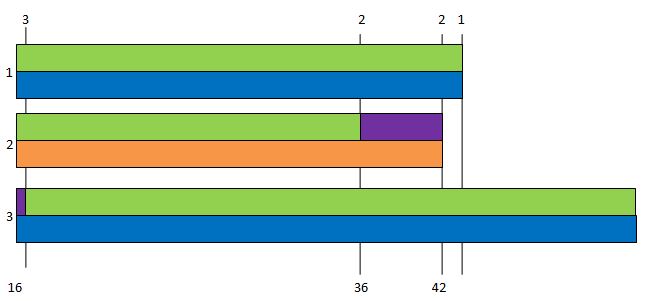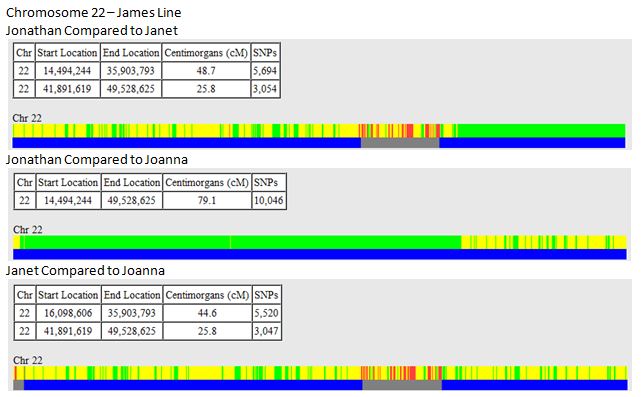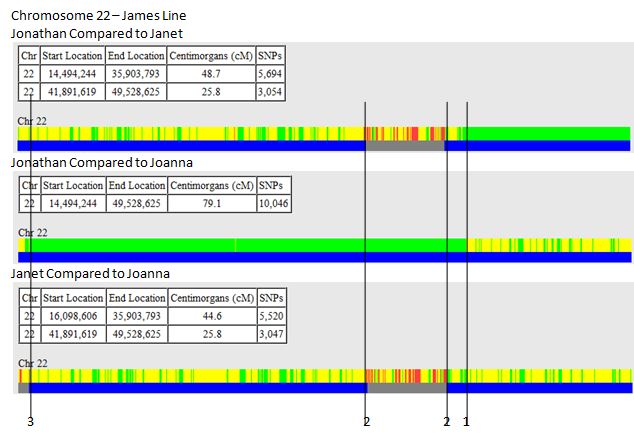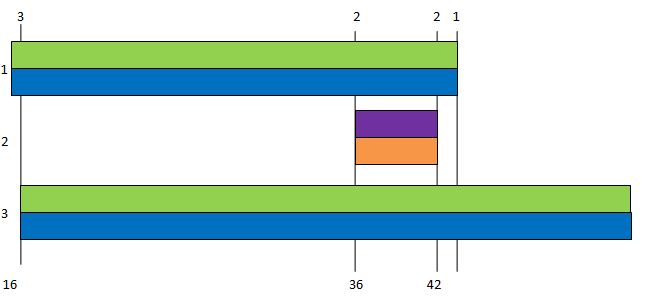Uh oh, this sounds like a boring topic. I have been blogging about Frazer Segments and Crossovers, and this is a continuation on the subject.
How To Find Frazer DNA Using Non-Frazer DNA
I suppose this is another way to say it. Joanna has just gotten in a match from her non-Frazer maternal side. How could this possibly give information on her Paternal Frazer side?
My Understanding of the DNA Facts of Life
When your (or my) parents procreated you, those 2 parent’s DNA combined to form your 2 sets of 22 Chromosomes. [We’ll leave the X and Y out of it for now.] But remember, your parents already had 2 sets of chromosome from their parents – your grandparents. When the DNA combined it was really the four grandparent’s DNA that was twisting and combining in different ways to form you and give your your maternal and paternal pair of chromosomes. When the twisting and recombining sorted itself out there were alternating segments of your 2 maternal grandparents on your maternal chromosome and alternating segments of your 2 paternal grandparents on the other paternal chromosome. The places where the segments changed from the DNA of one grandparent to the other is called the crossover point. This can be seen when the DNA of 3 siblings are compared.
The Gedmatch.com Comparison – One to One
Let’s take a peek at Joanna’s family’s Chromosome 22. This is the shortest of the chromosomes, so theoretically, it will have the fewest amount of segments and crossovers. Here we have 3 comparisons from gedmatch.com of Joanna’s family. The comparisons are stacked up on top of each other.
Now we need to know how Joanna’s grandparents’ DNA combined in her and her 2 sibs. The matches are in dark blue, but we want to know more than that. Let’s start with the comparison of Jonathan to Janet in the first row. From about 14 or 15 million to 36 million there is a half match also called a Half Identical Region (HIR). Then there is no match. After that there is a full match – technically called a Fully Identical Region. Now look at Jonathan compared to Joanna. Those two match the whole length. But there are still crossover points. From about 14 to 16 there is an HIR. Then there is an FIR in solid green. At the point where the HIR changes to a FIR is called a crossover point. That is where there is a change from one grandparent to the other.
Adding Crossover Points as Lines
Now I put in the crossover points as vertical lines. The person who has 2 crossovers in a line gets to own that crossover point. So along the first vertical line, there is a change from Jonathan to Joanna and from Janet to Joanna. Joanna is the one I see most often there, so she owns the first crossover. Here, I assign Jonathan a 1, Janet a 2 and Joanna 3 as having 3 J’s would be too confusing.
Maternal and Paternal Split In Joanna’s Family
Next we take what is shown above, and make it look more like a chromosome browser, except one that shows both maternal and paternal sides. It will look like a chromosome map. Let’s look at Jonathan compared to Joanna above. There is a FIR for segment 2-4. That means Jonathan and Joanna match on both their maternal and paternal side. That further means that they share the same maternal and paternal grandparent’s DNA at those locations. Seeing as we may not know which grandparents they are at this time, we give them a color. In this case, we’ll say that those matching grandparents are green and blue. Blue will be either a maternal or paternal grandparent and green will be the opposite. We don’t know this yet either. The green on Jonathan’s chromosome matches Joanna’s green and his blue matches Joanna’s blue on the other chromosome:
Above is the DNA from Jonathan’s and Joanna’s grandparents. One maternal and one paternal. Next according to Kathy Johnston, we can move 1 (Jonathan’s) grandparents to the left and 3 (Joanna’s) to the left. That is because there is no crossover point blocking them.
Note that from my first image above from gedmatch, Jonathan and Janet have no match in the third segment. This means Janet has to have the opposite 2 grandparents at this segment.
Unfortunately Janet’s segment (i.e. grandparent’s DNA) is trapped between her two (#2) vertical crossover points, so we can’t expand those segments. Next, we need to add the HIRs. But should we go the right, or to the left? Here is where I’m tempted to cheat a little. Joanna and family have Frazer cousin matches here:
So in what we are doing, that would be the paternal grandfather’s side.
On the maternal grandmother’s side there are 3 new matches.
As we don’t have anything for Janet in this area (15-25), I’ll choose to go that way, to see if it helps us at all. Jonathan and Janet are HIR for the 1st two segments, so on Janet’s bar (#2), we will extend one segment (randomly orange) to the left and change the other (from purple to green). Now you can see between bar #1 and #2 on the first 2 segments, they match on the top and not on the bottom. That is a HIR or half match. This meets what our gedmatch comparison was telling us was happening between this 2 siblings.
Then Janet and Joanna had no match in the lower left, so I made the Joanna (3) opposite to Janet (2). Choosing Janet’s half identical region sets a few things in motion. Recall that Joanna and her siblings each had a match to a maternal grandmother relative on this Chromosome 22. They were all around 15 or 16 to 25. Looking up and down to the right of the #3 crossover, the only color in common in that area is green. This gives us 3 important new pieces of information:
- Green has to represent Joanna’s family’s maternal grandmother.
- That also sets purple as the maternal grandfather (Henry Dickins)
- blue and orange now have to be Joanna’s family’s paternal grandparents.
Now we have gone from relative grandparents to actual maternal grandparents. But there is still more to fill in. We know from the Frazer DNA Project that Joanna’s family has 3 paternal grandfather (Frazer) matches here:
Too bad I don’t have them in the same order as the segment chart above. I think that the Frazer will be blue. Let’s guess that the last vertical crossover line is at position 45. From the area of 42-45, there are 3 of Joanna’s family who have matches with a Frazer. We already have 2 out of 3 blues available for these Frazer matches, so Frazer has to be blue. The last blue can be added on Janet’s row #3 in the small segment area of 42-45. We know from our first gedmatch comparison that Janet and Joanna have HIRs for the last 2 segments. I made Janet (2) have her paternal side blue so it matched with the other 2 Frazer matches. Then I made sure that between Janet and Joanna (2 and 3) their last segments didn’t match maternally on both sides. They had to match only one side. That was the Frazer side. Then the maternal side had to be purple for it to be a half match. Here is where Joanna’s family got their DNA from each grandparent. This was the beginning of Joanna and her siblings for Chromosome #22. It is pretty interesting that we can find out their grandparents’ contributing DNA considering these grandparents were all born in the 1800’s.
Now back to the original comparison:
I think everything holds together. Note that Joanna had only one crossover near the beginning. Janet has 2 in the middle and Jonathan has one at the end. This is portrayed in our Chromosome map in 4 colors also.
I had mentioned how some of my earlier analyses were using the longest and most difficult chromosomes. This should be a more simple and clearer example.
One Side Helps the Other
These 4 grandparents were determined using just 2 known matches to Joanna and her 2 siblings. One match was on the maternal side and one was on the paternal side. Once the maternal side was set, that made it easier to determine where the paternal match went. This process works because: 1) Joanna and her 2 siblings all tested their DNA and they can compare to each other using gedmatch.com; 2) There are known matches to Joanna and her siblings – one on the maternal side and one on the paternal side. These act as a reference to set where the 4 grandparents fit in for this analysis. It also helped that these matches matched all three siblings.
Applications
- Jonathan and Joanna cannot have any matches on their Seymour Line on Chromosome 22.
- Likewise, Janet cannot have a Seymour match above the region of about 42 million.
- Joanna will probably not have any meaningful matches with her Dickins Line on Chromosome 22.
- The family does not have parents available for DNA testing, so a match at any point for each of these siblings will still have to be checked to determine whether it is on the maternal or paternal side.
- Triangulation Groups will also follow the segment lines for each sibling
- Each of these 4 grandparent segments are made up of other smaller segments from their ancestors.









